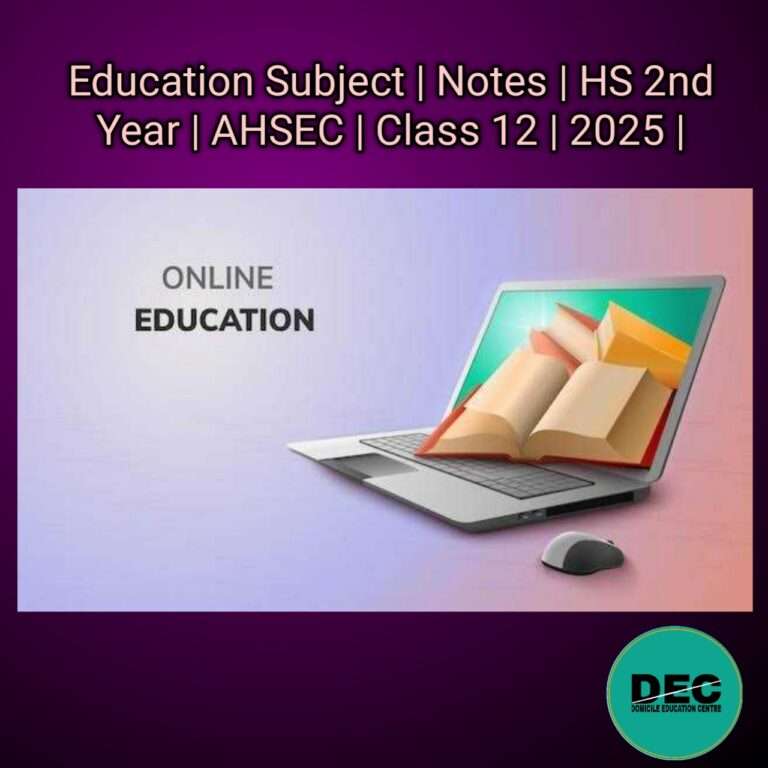Table of Contents
ToggleEducation Subject | Notes | HS 2nd Year | Class-12 | 2026 |
Subject : Education
Class-12 Education Subject Notes | AHSEC | 2025 |
EDUCATION
SYLLABUS FOR HIGHER SECONDARY COURSE
Introduction :
Education is a triune concept having three connection- a process, a product, and a discipline. Education as a discipline in an organized body of knowledge which deals with issues of what, why, how, who and even when in the educational process. Thus, as a subject of study ‘Education’ deals with such questions of context, reasons and methods and timing in the process of education as well as the background of the individual to be educated. These questions are under different specialization within the boarder field of education. The need of the subject ‘Education’ is felt, basically, for professional growth of teacher as well as those associated with various areas of education system. The Higher secondary courses in ‘Education’ is to be treated as a preparatory course leading to the higher study in the subject. Therefore, general objective of this course is to provided a general understanding of the basic and fundamental concepts of the subject and to create an appreciation towards the subject.
Subject: Education
100%
Common
All previous Year Questions Answer included in all the chapters
Just Click Here: Class-12 Education Subject Notes PDF.
General Objectives :
The specific objective of Higher Secondary Second year course are-
- to acquaint the students with the development trend of Secondary Education in India as well as in Assam.
- To make students familiar with the system of Non-formal Education as an alternative mode of formal education.
- to acquaint the students with different current trends in Education.
- To develop an understanding among the students about the psychological process of learning.
- To familiarize students with the mental process of memory, attention and interest as important elements in learning process.
- To make students aware about the importance of mental health and hygiene.
- To introduce students with the elementary statistical techniques.
Categories
EDUCATION
SYLLABUS FOR HIGHER SECONDARY FINAL YEAR COURSE
One Paper Time: Three hours Marks : 100
Unit-wise Distribution of Marks & Periods :
Unit No. Title Marks-Periods
Unit-I Development of Secondary 15-30
Education in India and Assam
(Post Independence Period).
Unit-II Non-formal Education. 10-20
Unit-III Current Trends in Education. 15- 30
Unit- IV Learning. 15-30
Unit-V Memory, Forgetting, Attention 15-30
and Interest.
Unit-VI Mental Health and Hygiene. 10-20
Unit-VII Elementary Educational 20-40
Statistics.
Total : 100-200
Unit-wise Distribution of Course Contents :
Unit-I : Development of Secondary Education in India and Assam
(Post Independence Periods) :
(a) Mudaliar Commission-
- Defects of education.
- Aims of education.
(b) Kothari Commission-
- Aims of education.
- Structural pattern.
- Vocationalisation of Secondary Education.
(c) National Policy of Education 1986 – Salient Features.
(d) Secondary Education in Assam in Post Independence Period-
- Development after Independence.
- Problems of Secondary Education in Assam.
Unit -II : Non-formal Education :
(a) Non-formal Education-
- Meaning, definition, objective, scope and Characteristics of Non-formal Education.
- Importance of Non-formal Education.
(b) Correspondence Education- Meaning, definition, objective and importance.
(c) Distance Education- Meaning, objective, merits and demerits.
(d) Open University- Meaning, objective and development of Open University.
Unit -III : Current Trends in Education :
(a) Environmental Education-
- Concept, objective and scope
- Need and importance
- Principles of Environmental Education.
- Environmental Education in Educational Institutions.
(b) Population Education-
- Concept, objective and Characteristic.
- Need and importance.
- Population and Education in Educational Institutions.
(c) Physical Education.
- Meaning and definitions.
- Need and importance.
- Physical Education in Educational Institutions.
(d) Value Education-
- Meaning and characteristics.
- Need and importance
- Value Education in Educational Institutions.
(e) Women Empowerment-
- Meaning and Definitions.
- Status of Women in India and Educational system.
- Education for women empowerment.
Unit- IV : Learning-
- Meaning, nature and characteristics.
- Learning and Maturation.
- Factors of learning.
- Methods of learning.
- Trial and Error.
- Learning by Conditioning.
- Insightful learning.
- Major laws of learning and their Educational significance.
Unit- V : Memory, Forgetting, Attention and Interest :
(a) Memory and Forgetting-
- Meaning and characteristics of Memory.
- The process of memorization.
- Types and marks of good memory.
- Improvement of memory.
- Meaning of forgetting.
- Causes of forgetting.
- Role of teacher in improvement of memory.
(b) Attention and Interest-
- Meaning and characteristics of attention.
- Determinants (conditions) of attention.
- Types of attention.
- Interest- Meaning, sources and types.
- Relation between attention and interest.
- Educational significance of attention and interest..
Unit- VI : Mental Health and Hygiene :
- Menatal Heath-
- Meaning and characteristics.
- Characteristics of a mentally healthy person.
- Mental Hygiene-
- Meaning, objectives and scope.
- Functions of Mental Hygiene.
- Home environment and Mental health.
- Mental health and school.
Unit -VII : Educational Statistics :
- Concept of Statistics, Uses of statistics in Education and Psychology.
- Statistical methods-
- Tabulation of data Frequency distribution table.
- Graphics representation of data- meaning, advantages, and rules- Histogram and Polygon.
- Diagram- Bar diagram and Pie-diagram.
- Measures of Central Tendency :
- Meaning and uses.
- Various measures of Central Tendency (Mean, Median and Mode)-Their meaning, uses, merits and demerits.
- Calculation of Mean, median and mode- from grouped and ungrouped data (In case of mean both long and short method.
- Measures of Variability-
- Meaning and uses.
- Various measures if variability
- Range-meaning, uses, merits- demerits and calculation.
- Quartile Deviation- meaning, uses, merits- demerits and calculation.
*****


Recent Comments